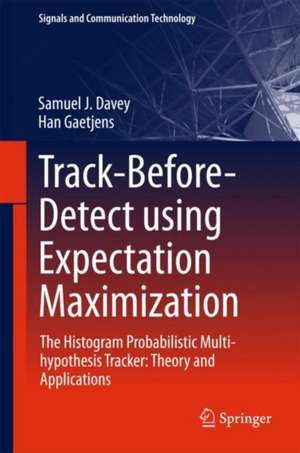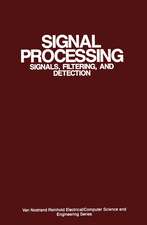Track-Before-Detect Using Expectation Maximisation: The Histogram Probabilistic Multi-hypothesis Tracker: Theory and Applications: Signals and Communication Technology
Autor Samuel J. Davey, Han X. Gaetjensen Limba Engleză Hardback – 20 mar 2018
| Toate formatele și edițiile | Preț | Express |
|---|---|---|
| Paperback (1) | 678.15 lei 38-45 zile | |
| Springer Nature Singapore – 16 dec 2018 | 678.15 lei 38-45 zile | |
| Hardback (1) | 650.69 lei 6-8 săpt. | |
| Springer Nature Singapore – 20 mar 2018 | 650.69 lei 6-8 săpt. |
Din seria Signals and Communication Technology
- 18%
 Preț: 952.89 lei
Preț: 952.89 lei - 18%
 Preț: 1559.80 lei
Preț: 1559.80 lei - 17%
 Preț: 361.80 lei
Preț: 361.80 lei - 18%
 Preț: 811.61 lei
Preț: 811.61 lei - 15%
 Preț: 585.26 lei
Preț: 585.26 lei - 18%
 Preț: 727.97 lei
Preț: 727.97 lei - 15%
 Preț: 585.90 lei
Preț: 585.90 lei -
 Preț: 393.35 lei
Preț: 393.35 lei - 20%
 Preț: 1002.73 lei
Preț: 1002.73 lei - 15%
 Preț: 641.71 lei
Preț: 641.71 lei - 20%
 Preț: 338.92 lei
Preț: 338.92 lei - 18%
 Preț: 1579.66 lei
Preț: 1579.66 lei - 18%
 Preț: 896.08 lei
Preț: 896.08 lei - 18%
 Preț: 847.11 lei
Preț: 847.11 lei - 18%
 Preț: 1234.77 lei
Preț: 1234.77 lei - 18%
 Preț: 905.54 lei
Preț: 905.54 lei - 15%
 Preț: 646.43 lei
Preț: 646.43 lei - 20%
 Preț: 662.48 lei
Preț: 662.48 lei - 15%
 Preț: 641.20 lei
Preț: 641.20 lei - 18%
 Preț: 1847.84 lei
Preț: 1847.84 lei - 18%
 Preț: 946.24 lei
Preț: 946.24 lei - 18%
 Preț: 1241.10 lei
Preț: 1241.10 lei - 20%
 Preț: 649.43 lei
Preț: 649.43 lei - 20%
 Preț: 993.28 lei
Preț: 993.28 lei - 18%
 Preț: 940.57 lei
Preț: 940.57 lei - 18%
 Preț: 1389.30 lei
Preț: 1389.30 lei - 20%
 Preț: 1003.50 lei
Preț: 1003.50 lei - 18%
 Preț: 953.52 lei
Preț: 953.52 lei - 20%
 Preț: 1001.16 lei
Preț: 1001.16 lei - 18%
 Preț: 1415.36 lei
Preț: 1415.36 lei - 15%
 Preț: 653.33 lei
Preț: 653.33 lei - 15%
 Preț: 645.60 lei
Preț: 645.60 lei - 15%
 Preț: 637.28 lei
Preț: 637.28 lei - 18%
 Preț: 948.79 lei
Preț: 948.79 lei - 18%
 Preț: 945.62 lei
Preț: 945.62 lei - 18%
 Preț: 836.36 lei
Preț: 836.36 lei - 18%
 Preț: 1225.46 lei
Preț: 1225.46 lei - 15%
 Preț: 635.01 lei
Preț: 635.01 lei - 15%
 Preț: 639.25 lei
Preț: 639.25 lei - 15%
 Preț: 646.30 lei
Preț: 646.30 lei - 15%
 Preț: 639.25 lei
Preț: 639.25 lei - 15%
 Preț: 712.36 lei
Preț: 712.36 lei - 20%
 Preț: 1006.12 lei
Preț: 1006.12 lei - 18%
 Preț: 970.56 lei
Preț: 970.56 lei
Preț: 650.69 lei
Preț vechi: 765.51 lei
-15% Nou
Puncte Express: 976
Preț estimativ în valută:
124.51€ • 133.14$ • 103.81£
124.51€ • 133.14$ • 103.81£
Carte tipărită la comandă
Livrare economică 18 aprilie-02 mai
Preluare comenzi: 021 569.72.76
Specificații
ISBN-13: 9789811075926
ISBN-10: 9811075921
Pagini: 331
Ilustrații: XXI, 352 p. 127 illus., 117 illus. in color.
Dimensiuni: 155 x 235 mm
Greutate: 0.7 kg
Ediția:1st ed. 2018
Editura: Springer Nature Singapore
Colecția Springer
Seria Signals and Communication Technology
Locul publicării:Singapore, Singapore
ISBN-10: 9811075921
Pagini: 331
Ilustrații: XXI, 352 p. 127 illus., 117 illus. in color.
Dimensiuni: 155 x 235 mm
Greutate: 0.7 kg
Ediția:1st ed. 2018
Editura: Springer Nature Singapore
Colecția Springer
Seria Signals and Communication Technology
Locul publicării:Singapore, Singapore
Cuprins
Foreword.- Introduction.- Idealised Track-Before-Detect.- Point Measurement Probabilistic Multi-Hypothesis Tracking.- Histogram ProbabilisticMulti-Hypothesis Tracking.- Implementation Considerations.- Poisson Scattering Field.- Non-linear Non-Gaussian Targets.- Adaptive Appearance Models.- H-PMHT with Attribute Data.- Radar and Sonar Track-Before-Detect.- Tracking in Full Motion Video.- Related Methods.- Summary and Prognostications.
Notă biografică
Samuel Davey studied engineering and mathematics at the University of Adelaide, culminating with a Ph.D. in signal processing in 2003. He has worked for the Defence Science and Technology Group, Australia, since 1995 in the areas of target tracking, tracker performance assessment, and multi-sensor
fusion; he is currently Group Leader, Geophysical Phenomenology and Performance Assessment. He is also a Visiting Research Fellow at the University of Adelaide, a senior member of the IEEE, and an associate editor of IEEE Signal Processing Letters. He is a co-author of the book Bayesian Methods in the Search for MH370. He received the 2011 JP LeCadre award for the best paper at the International Conference on Information Fusion and the 2012 DST Science and Engineering Excellence award for work on H-PMHT that led to this book.
Han Gaetjens received an Honours degree in Mathematics from the University of South Australia in 2007 and the Ph.D. from the University of Adelaide in 2015. She has worked for the Defence Science and Technology Group, Australia, since 2007.
fusion; he is currently Group Leader, Geophysical Phenomenology and Performance Assessment. He is also a Visiting Research Fellow at the University of Adelaide, a senior member of the IEEE, and an associate editor of IEEE Signal Processing Letters. He is a co-author of the book Bayesian Methods in the Search for MH370. He received the 2011 JP LeCadre award for the best paper at the International Conference on Information Fusion and the 2012 DST Science and Engineering Excellence award for work on H-PMHT that led to this book.
Han Gaetjens received an Honours degree in Mathematics from the University of South Australia in 2007 and the Ph.D. from the University of Adelaide in 2015. She has worked for the Defence Science and Technology Group, Australia, since 2007.
Textul de pe ultima copertă
This book offers a detailed description of the histogram probabilistic multi-hypothesis tracker (H-PMHT), providing an accessible and intuitive introduction to the mathematical mechanics of H-PMHT as well as a definitive reference source for the existing literature on the method. Beginning with basic concepts, the authors then move on to address extensions of the method to a broad class of tracking problems. The latter chapters present applications using recorded data from experimental radar, sonar and video sensor systems. The book is supplemented with software that both furthers readers’ understanding and acts as a toolkit for those who wish to apply the methods to their own problems.
Caracteristici
Presents the only comprehensive reference source for the probabilistic multi-hypothesis tracker (PMHT) algorithm Offers an accessible introduction to the method, including an intuitive derivation Provides application examples




























